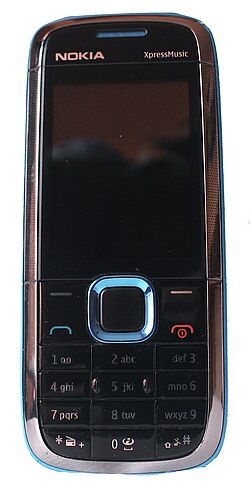 Nokia 5130 XpressMusic (blue edition) | |
| Also known as | Nokia 5130c, Nokia 5130c-2, Nokia RM-495, Nokia RM-496 [1] |
|---|---|
| Manufacturer | Nokia |
| First released | November 2008 |
| Availability by region | February 2009 |
| Discontinued | January 2011 |
| Predecessor | Nokia 5310 Nokia 5220 Nokia 3110 classic |
| Successor | Nokia X2-00 Nokia X2-01 |
| Compatible networks | |
| Form factor | Candybar |
| Dimensions | 107.5 mm (4.23 in) H 46.7 mm (1.84 in) W 14.8 mm (0.58 in) D |
| Weight | 88 g (3.1 oz) |
| Operating system | Series 40 (5th edition Feature Pack 1 [1] ) |
| CPU | 234 MHz ARM9 |
| Removable storage | microSDHC (supports up to 32 GB) |
| Battery | Li-ion (BL-5C, [1] 1020 mAh) Battery Life
|
| Charging | 2.0 mm charger connector [1] |
| Rear camera | 2 MP with 4x digital zoom, video recording (128×96 px. or 176×144 px. at 15 fps max.) |
| Display | LCD 240x320 px QVGA Colors: 256 thousand (24-bit) [1] Resolution: 240 × 320 pixels (QVGA) |
| Sound | 3.5mm stereo audio jack [1] (Supported audio formats: WAV, AAC, eAAC, eAAC+, MP3, MP4, MIDI, WMA, WAMR, MXMF, AMR) |
| Connectivity | built-in Micro-USB (hot swap) [1] Bluetooth 2.0 with A2DP [1] |
| Data inputs | Keypad |
| Other | FM radio Standard 3.5 mm headphone jack, [1] voice memo Games: Bounce Tales, Rally 3D, Snake III [2] |
Nokia 5130 XpressMusic is a mobile phone manufactured by Nokia. [3] It belongs to the XpressMusic series of phones, and runs on Nokia's Series 40 platform. [4] [5] The phone used to be one of the best selling Nokia phones in India. [6]